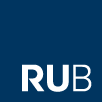Report to the 22. DMG Shortcourse "Applications of Solid State NMR Spectroscopy in the mineralogical and geoscientific research "
in Bochum from 10. June- 13. June 2025

From June 10th to 13th, 2025, the DMG Short Course on the Application of Solid-State NMR Spectroscopy in Geosciences took place for the 22nd time at the Institut für Geologie, Mineralogie und Geophysik at Ruhr University Bochum. Supervised by Dr. Michael Fechtelkord, seven participants from various disciplines took part in the event – including three master's students, three doctoral students with research focuses in geosciences and cement research, and an industrial employee with NMR experience from Tübingen, Potsdam, Munich, and Ludwigshafen.
The first day began with an introduction to the physical principles of NMR spectroscopy, its historical development, instrumental design, and typical pulse sequences for measuring spin-lattice relaxation times. The focus then shifted to the detailed theory of proton relaxation (1H), including the BPP equation for describing dynamic processes. In the afternoon, the theory was applied directly in practice using temperature-dependent T1 experiment on tetramethylammonium iodide (TMEAI). Under supervision, the participants conducted initial experiments on the NMR spectrometer, determined relevant parameters such as pulse lengths and RF field strengths, and evaluated the obtained data using traditional semi-logarithmic paper. Activation energies and correlation times were determined from the T1 data. The evening concluded with a social gathering at the "Filou" pub on Buscheyplatz.
The second day was devoted to the fundamentals of magnetic interactions – in particular homonuclear and heteronuclear dipolar coupling and chemical shift. Following the theoretical introduction, the concept of magic angle spinning (MAS) as an averaging technique was presented. In the subsequent practical session, participants conducted MAS NMR experiments on synthetic minerals (1H, 19F, and 29Si), including aluminum-rich F/OH phlogopite. The spectra were analyzed in the afternoon using the DmFit2023 software. The focus was on fitting line shapes, incorporating sidebands, and interpreting chemical shifts.
The third day of the workshop focused on the application of multipulse techniques. After an introduction to the Hahn echo, various correlation experiments were discussed, including cross-polarization magic angle spinning (CPMAS), the Incredible Natural Abundance Double Quantum Transfer Experiment (INADEQUATE), and heteronuclear coupling. In the practical session, participants conducted contact-time-dependent CPMAS experiments on kaolinite. Among other things, the Hartmann-Hahn condition was established and pulse lengths and RF field strengths were determined. In the evaluation section, H–Si distances were calculated using the second moment and graphically presented using Excel. This was complemented by an in-depth introduction to spectral analysis using DmFit2023, focusing in particular on anisotropies and line shape parameters.
The final day addressed the theoretical and experimental challenges involved in investigating nuclei with a nuclear spin I > 1/2. After an introduction to quadrupole interactions and their effects on spectra under MAS conditions, various NMR methods were presented, including:
• Double Rotation (DOR)
• Multi-Quantum Magic Angle Spinning (MQMAS)
• Satellite Transition Spectroscopy (SATRAS)
In the practical section, participants conducted 23Na MAS experiments on selected salts and a 27Al SATRAS measurement on corundum. The subsequent spectra analysis with DmFit2023 enabled a detailed analysis of quadrupole line shapes and satellite transitions.
In the concluding discussion, impressions were gathered, suggestions discussed, and the results of the intensive four days were reflected upon. Participants' feedback was consistently positive. The balanced combination of theory and practice, the high level of expertise, and the lively and vivid presentation by Dr. Fechtelkord were particularly emphasized.
Overall, the workshop offered a balanced mix of theoretical knowledge and practical experience. The diverse applications of solid-state NMR spectroscopy were presented comprehensively and in a practical manner. Thanks to the clearly structured organization, the lively presentation style, and the memorable, comparison-based explanations, even complex processes could be understood and the enthusiasm of all participants was aroused.
Isabelle Hartleib Felix Reinhard Nimo Radtke
Tübingen Tübingen Potsdam


